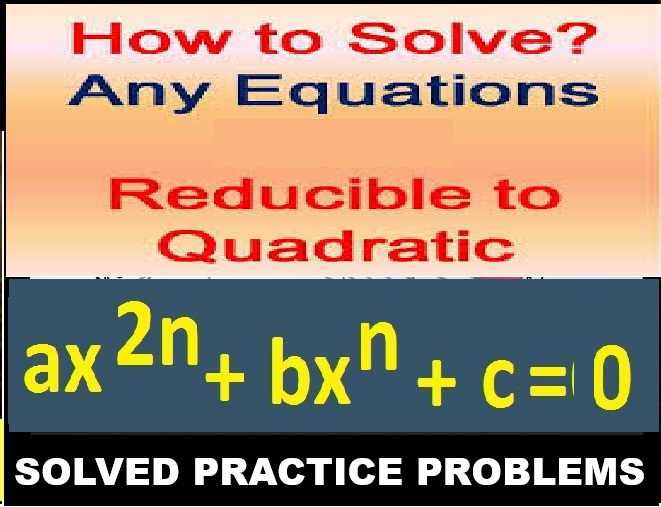Symmetry ICSE Class-7th Concise Selina Mathematics Solutions Chapter-17. We provide step by step Solutions of Exercise / lesson-17 Symmetry (Including Reflection and Rotation) for ICSE Class-7 Concise Selina Mathematics. Our Solutions contain all type Questions of Exe-17 A, Exe-17 B and Exe-17 C, to develop skill and confidence. Visit official Website CISCE for detail information about ICSE Board Class-7 Mathematics.
Symmetry ICSE Class-7th Concise Selina Mathematics Solutions Chapter-17
–: Select Topics :–
Exercise – 17 A Symmetry for ICSE Class-7th Concise Mathematics Selina Solutions
Question 1.
For each figure, given below, draw the line (s) of symmetry, if possible :


Answer
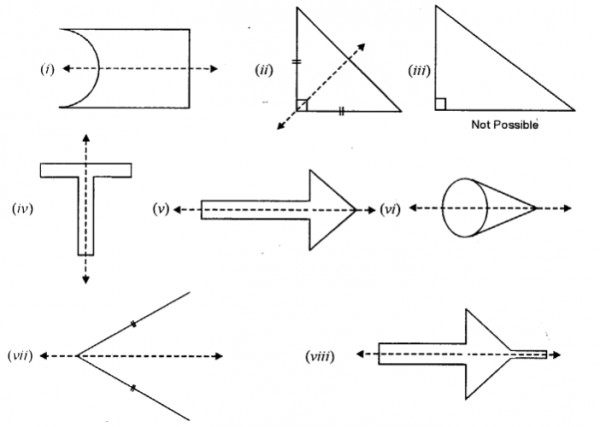
Question 2.
Write capital letters A to Z of English alphabet ; and in each case, if possible, draw the largest number of lines of symmetry.
Answer
Line or lines of symmetry’ is possible in the following alphabets :
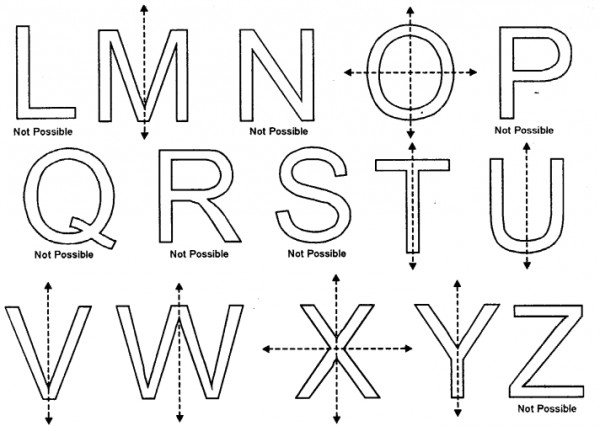
For other alphabets, it is not possible
Question 3.
By drawing a free hand sketch of each of the following, draw in each case, the line (s) of symmetry,
if any:
(i) a scalene triangle
(ii) an isosceles right angled triangle
(iii) a rhombus
(iv) a kite shaped figure triangle.
(v) a rectangle
(vi) a square
(vii) an isosceles
Answer

Question 4.
Draw a triangle with :
(i) no line of symmetry,
(ii) only one line of symmetry,
(iii) exactly two lines of symmetry,
(iv) exactly three lines of symmetry,
(v) more than three lines of symmetry.
In each case, if possible, represent the line/ lines of symmetry by dotted lines. Also, write the special name of the triangle drawn.
Answer
(i)
Scalene triangle:
It has no line of symmetry.

(ii)
Isosceles Triangle:
It has one line of symmetry as shown.
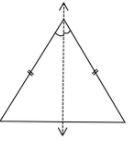
(iii) It is not possible.
(iv) Equilateral Triangle
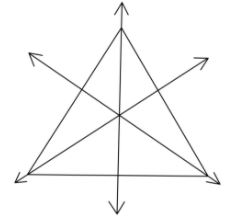
(v) It is not possible.
Question 5.
Draw a quadrilateral with :
(i) no line of symmetry.
(ii) only one line of symmetry.
(iii) exactly two lines of symmetry.
(iv) exactly three lines of symmetry.
(v) exactly four lines of symmetry.
(vi) more than four lines of symmetry.
In each case, if possible, represent the line/ lines of symmetry by dotted lines. Also, write the special name of the quadrilateral drawn.
Answer
(i)
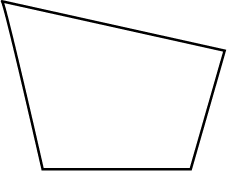
(ii)
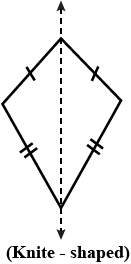
(iii)
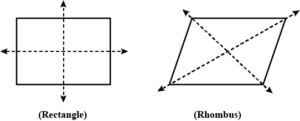
(iv) Not possible
(v)
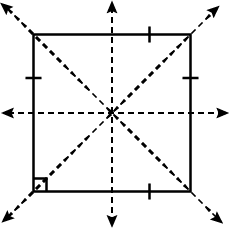
(vi) Not possible
Question 6.
Construct an equilateral triangle with each side 6 cm. In the triangle drawn, draw all the possible lines of symmetry.
Answer
Steps :
(i) Draw a line segment BC = 6 cm
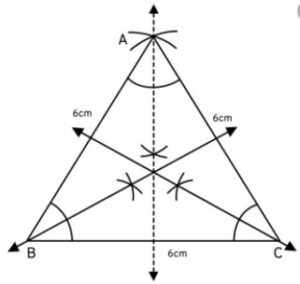
(ii) With centres B and C and radius 6 cm, draw two arcs intersecting each other at A.
(iii) Join AB and AC
∆ ABC is the required equilateral triangle,
(iv) Draw the angle bisectors of ∠A, ∠B, and ∠C.
These are the lines of symmetry which are three in numbers as the triangle is equilateral.
Question 7.
Construct a triangle ABC in which AB = AC = 5cin and BC = 5.6 cm. If possible, draw its lines of symmetry.
Answer
Steps:
(i) Draw a line segment BC = 5.6 cm
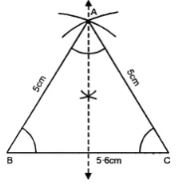
(ii) With centres B and C and radius 5 cm, draw two arcs intersecting each other at A.
(iii) Join AB and AC.
∆ ABC is an isosceles triangle.
(iv) Draw the bisector of ∠A. This is the only one line of symmetry as the triangle is an isosceles.
Question 8.
Construct a triangle PQR such that PQ = QR = 5 .5 cm and angle PQR = 90°. If possible, draw its lines of symmetry.
Answer
∴ ∠PQR = 90°,
and ∠P = ∠R …………(opposite sides are equal)
∴∠P + ∠R = 90°
Hence,
ZP = ZR = = 45°
Steps :
(i) Draw a line segment QR = 5.5 cm
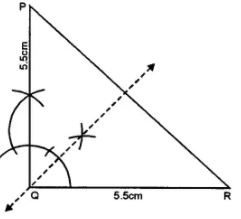
(ii) At Q, draw a ray making an angle of 90° and cut off QP = 5.5 cm.
(iii) Join PR.
∆ PQR is an isosceles triangle.
(iv) Draw the angle bisector of ∠PQR. It is the line of symmetry. Since the triangle is an isosceles.
∴It has only one line of symmetry.
Question 9.
If possible, draw a rough sketch of a quadrilateral which has exactly two lines of symmetry.
Answer
The quadrilateral has exactly two lilies of symmetry
∴ It must be a rectangle or a rhombus
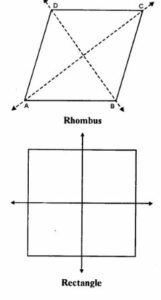
Question 10.
A quadrilateral ABCD is symmetric about its diagonal AC. Name tire sides of this quadrilateral which are equal.
Answer
The quadrilateral ABCD is symmetric about its diagonal AC.
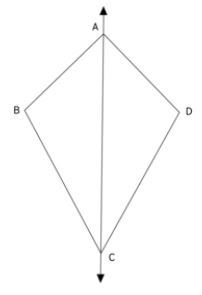
∴ It must be a kite-shaped.
Hence,
side AB = AD and BC = DC.
Selina Solutions of Exercise – 17 B Symmetry for ICSE Class-7th Concise Mathematics
Question 1.
In each figure, given below, find the image of the point P in the line AB :

Answer
(i)
Steps:
From P, draw a perpendicular to the given line AB meeting it at O.
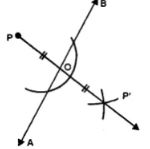
(ii)
Steps :
Produce PO to P’ such that OP’ = PO.
P’ is the required image of P in AB.
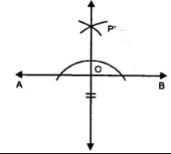
Question 2.
In each figure, given below, find the image of the line segment AB in the line PQ :

Answer
(i)
Steps:
(a) From A and B, draw perpendiculars on PQ intersecting PQ at L and M.
(b) Produce AL to A’ such that AL = LA’ and produce BM to B’ such that BM = MB’ A’B’ is the image of the line segment AB in PQ.
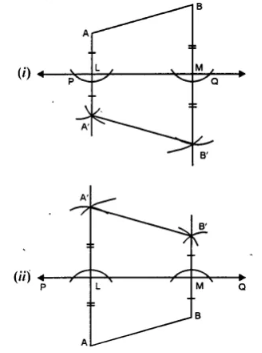
(ii)
Steps :
(i) From A and B, draw perpendiculars on PQ intersecting PQ at L and M.
(ii) Produce AL to A’ such that AL = LA’ and produce BM to B’ such that BM = MB’ A’B’ is the image of the line segment AB in PQ.
Question 3.
Complete the following table :

Answer
| Point | Reflection in | ||
| x-axis | y-axis | origin | |
| (i) (8, 2) | (8, − 2) | (− 8, 2) | (− 8, − 2) |
| (ii) (5, 6) | (5, − 6) | (− 5, 6) | (− 5, − 6) |
| (iii) (4, − 5) | (4, 5) | (− 4, − 5) | (− 4, 5) |
| (iv) (6, − 2) | (6, 2) | (− 6, − 2) | (− 6, 2) |
| (v) (− 3, 7) | (− 3, − 7) | (3, 7) | (3, − 7) |
| (vi) (− 4, 5) | (− 4, − 5) | (4, 5) | (4, − 5) |
| (vii) (− 2, −7 ) | (− 2, 7) | (2, − 7) | (2, 7) |
| (viii) (− 6, − 3) | (− 6, 3) | (6, − 3) | (6, 3) |
| (ix) (4, 0) | (4, 0) | (− 4, 0) | (− 4, 0) |
| (x) (− 7, 0) | (− 7, 0) | (7, 0) | (7, 0) |
| (xi) (0, − 6) | (0, 6) | (0, − 6) | (0, 6) |
| (xii) (0, 7) | (0, − 8) | (0, − 8) | (0, − 8) |
| (xiii) (0, 0) | (0, 0) | (0, 0) | (0, 0) |
Question 4.
A point P (7,3)|is reflected in x-axis to point P’. The point P’ is further reflected in v-axis to point P” Find :
(i) the co-ordinates of P’
(ii) the co-ordinates of P”
(iii) the image of P (7, 3) in origin.
Answer
(i) Image of point P (7,3), when reflected in x-axis, is P’ whose coordinates will be (7,-3)
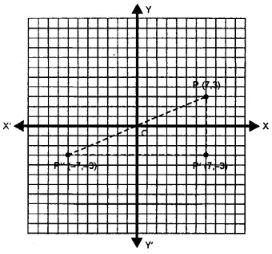
(ii) Image of point P’ (7,-3) when reflected in y-axis, is P” whose co-ordinates will be (- 7,-3)
(iii) The image of P (7, 3) in origin is P” whose coordinates are (- 7, – 3).
Question 5.
A point A (- 5, 4) is reflected in y-axis to point B. The point B is further reflected in origin to point C. find :
(i) the co-ordinates of B
(ii) the co-ordinates of C
(iii) the image of A (- 5, 4) in x-axis.
Answer
(i) Image of point A (- 5,4), when reflected in y-axis, is B whose co-ordinates will be (5,4)
(ii) Image of B (5, 4), when reflected in origin, is C whose co-ordinates will be (- 5, – 4)
(iii) Image of A (- 5,4) in x-axis is C whose co-ordinates are (- 5, – 4)
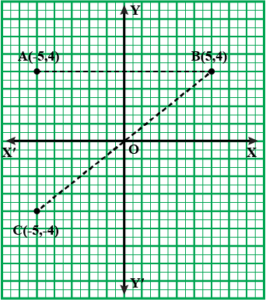
Question 6.
The point P (3, – 8) is reflected in origin to point Q. The Point Q is further reflected in x-axis to point R. Find :
(i) the co-ordinates of Q
(ii) the co-ordinates of R
(iii) the image of P (3, – 8) in y-axis.
Answer
(i) The image of the given point P (3, – 8) when reflected in origin is Q whose co-ordinates will be (- 3, 8).
(ii) The image of Q (- 3, 8) when reflected in x-axis is R whose co-ordinates will be (-3,-8)
(iii) The image of P (3, 8) in y-axis is R whose co-ordinates are (- 3, – 8).
Question 7.
Each of the points A (3, 0), B (7, 0), C (- 8, 0), D (- 7, 0) and E (0, 0) is reflected in x-axis to points A’, B’, C’, D’ and E’ respectively. Write the co-ordinates of each of the image points A’, B’, C’, D’ and E’.
Answer
The points are given :
A (3, 0), B (1, 0), C (-8, 0), D (- 7, 0) and E (0, 0)
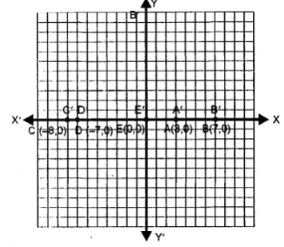
This images will be when reflected in x-axis.
A’ (3, 0),
B’ (7, 0),
C’ (- 8, 0)
D’ (- 7, 0)
E’ (0, 0)
as the given points lie on x-axis.
Question 8.
Each of the points A (0, 4), B (0, 10), C (0, – 4), D (0, – 6) and E (0, 0) is reflected in y-axis to points A’, B’, C’, D’ and E’ respectively. Write the co-ordinates of each of the image points A’, B’, C’, D’ and E’.
Answer
The pointsgiven are:
A (0, 4),
B (0, 10),
C (0, – 4),
D (0, – 6)
E (0, 0)
are reflected in y-axis.
The co – ordinates of their images will be
A’ (0, 4),
B’ (0, 10),
C’ (0, – 4)
D’ (0, – 6)
E’ (0, 0)
as they all lie on y-axis.
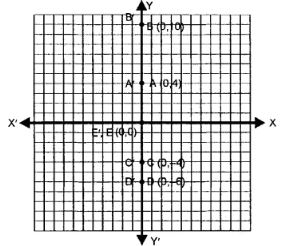
Question 9.
Each of the points A (0, 7), B (8. 0), C (0, -5), D (- 7, 0) and E (0, 0) are reflected in origin to points A’, B’, C’, D’ and E’ respectively. Write the co-ordinates of each of the image points A’, B’, C’, D’ and E’.
Answer
The points
A (0, 7),
B (8, 0),
C (0, – 5),
D (– 7, 0)
E (0, 0) are reflected in origin.
So, the co-ordinates of their images will be
A’ (0, – 7),
B’ (– 8, 0),
C’ (0, 5),
D’ (7, 0)
E’ (0, 0)
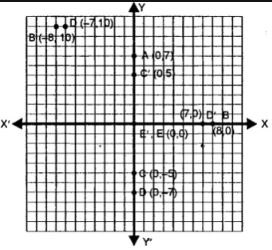
Question 10.
Mark points A (4, 5) and B (- 5, 4) on a graph paper. Find A’, the image of A in x-axis and B’, the image of B in x-axis.
Mark A’ and B’ also on the same graph paper.
(ii) Join AB and A’ B’ and
find if AB = A’ B’ ?
Answer
The given points:
A (4, 5) and B (− 5, 4) have been marked on the graph.
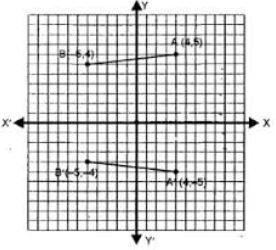
The image of A in x-axis A (4, – 5) and image of B in x-axis is B’ (− 5, − 4) which have been also plotted on the same graph.
AB and A’ B’ are joined.
We see that AB = A’ B’.
Question 11.
Mark points A (6, 4) and B (4, – 6) on a graph paper.
Find A’, the image of A in y-axis and B’, the image of B in y-axis. Mark A’ and B’ also on the same graph paper.
Answer
The given points are A (6, 4) and B (4, – 6)
The images of A and B are y-axis are A’ (– 6, 4)
B’ (– 4, – 6) respectively as shown in the same graph.
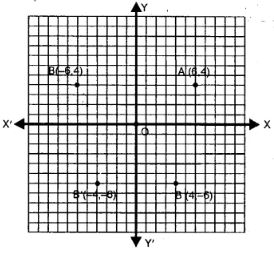
Question 12.
Mark points A (- 6, 5) and B (- 4, – 6) on a graph paper. Find A’, the image of A in origin and B’, the image of B in origin. Mark A’ and B’ also on the same graph paper. Join AB and A’ B’. Is AB = A’ B’ ?
Answer
The given points are A (– 6, 5) and B (– 4, – 6). The images of A and B in the origin are A’ and B’ where co-ordinates are A’ (6, – 5) and B’ (4, 6) which have been plotted on the same graph.
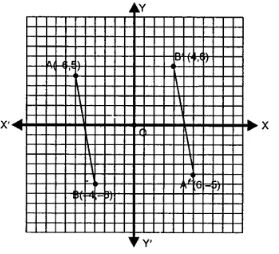
AB and A’ B’ are joined we see that AB = A’ B’.
ICSE Class-7 Symmetry Exe-17 C Concise Mathematics Selina Solutions
Question 1.
How many lines of symmetry does a rhombus have?
Answer
It has two lines of symmetry.
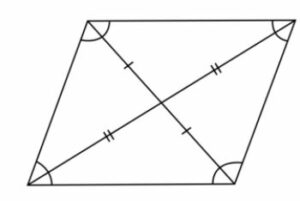
Question 2.
What is the order of rotational symmetry of a rhombus?
Answer
The order of rotational symmetry can be defined as the number of times that shape appears exactly the same during a full 360° rotation. The order of rotational symmetry of a rhombus is 2.
Question 3.
Show that each of the following figures has two lines of symmetry and a rotational.

Answer

Question 4.
Name a figure that has a line of symmetry but does not have any rotational symmetry.
Answer
An isosceles triangle has only line symmetry and no rotational symmetry.
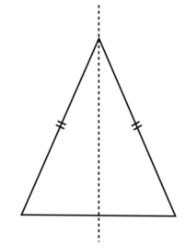
Question 5.
In each of the following figures, draw all possible lines of symmetry and also write the order of rotational symmetry:

Answer :
(i) It has no proper line of symmetry and order of rotational symmetry is 3
(ii) It has 2 lines of symmetry and the order of rotational symmetry is 4.
(iii) It has 2 lines of symmetry and the order of rotational symmetry is 2.
(iv) It has no proper line of symmetry and the order of rotational symmetry is 0.
(v) It has 1 line of symmetry and the order of rotational symmetry is 0.
— End of Symmetry ICSE Class-7th Solutions :–
Return to – Concise Selina Maths Solutions for ICSE Class -7
Thanks


